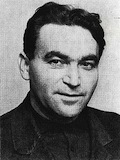Rudolf Vrba (1924-2006), one of the few prisoners to escape from Auschwitz, brought news of the death camp to the free world and helped galvanize the calls for an Allied bombing of the site.
On April 7, 1944, as the Germans began preparing to deport Hungary’s approximately 800,000 Jews to Auschwitz, Vrba and fellow-inmate Alfred Wetzler slipped away from their slave labor battalion and hid in a hollowed-out woodpile near the edge of the camp. On the advice of Soviet prisoners of war, the fugitives sprinkled the area with tobacco and gasoline, which confused the German dogs that were used to search for them. Three days later, they emerged from the woodpile and began an eleven-day, eighty-mile trek to neighboring Slovakia.
There they met with Jewish leaders and dictated a thirty-page report that came to be known as the “Auschwitz Protocols.” It included details of the mass-murder process, maps pinpointing the gas chambers and crematoria, and warnings of the impending slaughter of Hungary’s Jews. “One million Hungarian [Jews] are going to die,” Vrba told them. “Auschwitz is ready for them. But if you tell them now, they will rebel. They will never go to the ovens.” A copy of the report was given to Rudolf Kastner, a Budapest Jewish leader. Instead of publicizing the information, Kastner negotiated a deal that involved bribing the Germans to permit a train with 1,684 of his relatives, friends, and Hungarian Jewish leaders to leave the country. Kastner’s action became the centerpiece of a controversial trial in Israel after the war.
Another copy of Vrba’s Auschwitz Protocols was given to Rabbi Michoel Dov Weissmandl, a rescue activist in Bratislava, who then wrote the first known appeal for the use of Allied air power to disrupt the mass murder. Weissmandl’s plea to the Allies to bomb the railroad lines between Hungary and Auschwitz reached the Roosevelt administration in June, but was quickly rejected.
Vrba’s report convinced the Jewish Agency leadership in Palestine to change its position on bombing. Agency leaders initially opposed bombing Auschwitz because they believed it was a labor camp, not a death camp. But after receiving the Auschwitz Protocols in June, Agency officials lobbied British, American, and Soviet officials to bomb the camp or the railways leading to it. Their requests were rebuffed.
A condensed version of the Auschwitz Protocols reached the U.S. government’s War Refugee Board in June. It helped galvanize the Board to mobilize international pressure on Hungary to halt the deportations to Auschwitz. Although that effort came too late to for the over 400,000 Hungarian Jews who had been shipped to their doom, it did spare the 200,000-plus who were still alive in Budapest.
The full version of the Vrba report was actually held up in Switzerland for three months by U.S. diplomats who regarded it as low priority. When the report finally reached Washington in October, the Office of War Information opposed distributing it; OWI director Elmer Davis claimed the report was actually part of a Nazi conspiracy to “create contempt for the [Jewish] inmates” by showing that the Jews were not resisting their killers.
In 2010, the Franklin and Eleanor Roosevelt Institute purchased Vrba’s papers from his family. At a conference about Vrba that was held in New York City in April 2011, Institute president William J. vanden Heuvel said the significance of Vrba’s story was that until his escape, the Free World knew very little about Auschwitz and therefore the Roosevelt administration should not be criticized for rejecting requests to bomb the death camp. However, Prof. Randolph Braham, director of the City University of New York’s Rosenthal Institute for Holocaust Studies, which sponsored the conference, said: “The leaders of the world…were fully familiar with the details of Auschwitz. This was even before Rudi [Vrba] escaped.”
Sources: Wyman, The Abandonment of the Jews, pp.288-289; Medoff, FDR and the Holocaust, pp.170, 173-174.










